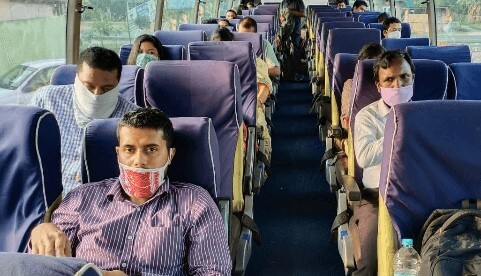Dear Bus Entrepreneur Operators and Friends,
We are happy to serve bus operators who are plying buses on the road since 19th May, after the Karnataka government started to relax restrictions. The number of booking transactions using Bitla GDS software has steadily increased day-by-day. We believe these are early days in the long recovery path for the bus industry, which is likely to span over several months.
Nearly 100 bus operators have started plying buses in Karnataka with safety precautions. During the initial days, customers were unsure about safety, and bus operators were unsure of how many buses to ply. Over the last 4 weeks, those operators who have adhered to maximum customer safety standards have seen a steady increase in demand and have gradually increased the number of buses. We are sharing our experiences on the subject of customer safety to all other bus operators, especially those who are keenly watching from the other states.
To study the full range of customer safety and hygiene, it is most appropriate to imagine yourself as a customer and assess hygiene conditions at each stage of the travel experience viz. booking tickets, travelling to boarding-point, and waiting for the bus, boarding the bus and travelling inside the bus.
Let us study each stage of the customer’s travel experience in more detail.
Stage 1 – While booking tickets
Customers book tickets using an OTA (mobile app, website), at the branch office, with the bus agent, or with the bus operator’s internet properties (mobile app, website). During pre-COVID times, OTAs had a 65% share, while branching & agent bookings had 32% share and bus operators e-booking had a 3% share of all bookings across India on an average using the Bitla platform. Keeping in mind social distancing norms and increased consciousness about hygiene, we expect the internet modes of the booking will naturally increase, while in-person modes of the booking will reduce. Our platform is gearing up for this new reality to help bus operators to ensure that no bookings are lost. We encourage all bus operators to use our white-labeled mobile booking app and promote it amongst your customers. We are also enhancing the Bitla payments platform to ensure all digital payment choices are available to branch booking officers and booking agents. This will ensure that the booking experience for customers is completely safe, even if customers choose to book at the branch office or with an agent.
Stage 2 – While waiting at the boarding point
Unlike the bus interiors, most boarding points are not owned by anyone – bus operators, state bus association or local government. It is therefore natural that nobody is taking specific interest to sanitize and give a hygienic feel to these shared public places. When customers arrive at the boarding point, they feel vulnerable. This is an area of concern, which has to be solved by everyone in the bus fraternity by coming together. Customers who have a bad experience are unlikely to travel again. In the upcoming months, while generating customer demand and keeping occupancy high are challenging, this situation is best avoided. It calls for immediate action. State bus associations can take the lead to create a joint action committee and everyone else can join to participate and ensure that customers get a hygienic feel at all boarding points.
Stage 3: While boarding the bus
After the bus arrives at the boarding point, customers will board the bus. We have observed that bus operators are taking elaborate measures to sense the body temperature of customers and give them hand sanitizer. These are important pre-boarding steps to prevent the spread of the virus and build the confidence of customers about safety precautions. The conductor verifies the ticket of the customer, which requires them to come in close physical proximity to read the customer’s mobile ticket information. At Bitla, we are working to solve this problem by allowing the conductor to scan a QR code on the customer’s phone, or customer’s mobile to silently send ticket information to the conductor’s ticketing mobile device from a distance. This will ensure that the conductor can onboard customers by getting all ticket information, in addition to giving a safe onboarding experience to customers.
Stage 4: While travelling in the bus
We have observed that bus operators have taken all precautions to maintain hygiene inside the bus – including sanitizing the bus after each trip, providing disposable pillow covers & blankets, and reserving empty seats between two strangers to maintain social distancing.
To have sustained demand for buses, customers have to feel safe each time they travel and at all stages of their travel experience. These stages are like links in a chain. The chain is as strong as its weakest link, and will first break at the weakest link. In this chain of travel experience, the weakest link are the moments when customers spend time waiting at the boarding point. This problem should be solved. Remember that many customers do have a choice of other modes of intercity travel – personal car, train, or flight depending on the route and availability. There is however an opportunity for everyone in the bus fraternity to come together and make bus travel safer.
